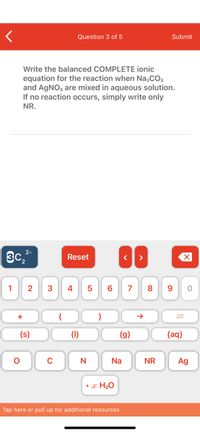
Chemistry
10th Edition
ISBN: 9781305957404
Author: Steven S. Zumdahl, Susan A. Zumdahl, Donald J. DeCoste
Publisher: Cengage Learning
expand_more
expand_more
format_list_bulleted
Question

Transcribed Image Text:**Question 3 of 5**
Write the balanced COMPLETE ionic equation for the reaction when Na₂CO₃ and AgNO₃ are mixed in aqueous solution. If no reaction occurs, simply write only NR.
---
**Explanation:**
This question asks for the balanced complete ionic equation of a reaction between sodium carbonate (Na₂CO₃) and silver nitrate (AgNO₃) in aqueous solution. If no reaction takes place, the answer should be "NR" (No Reaction).
**Virtual Keyboard:**
At the bottom of the screen, there is a virtual keyboard with various elements and symbols used in writing chemical equations, such as:
- Numbers (0-9)
- Common ions (e.g., C₂²⁻)
- Symbols for states of matter: (s) for solid, (l) for liquid, (g) for gas, and (aq) for aqueous
- Chemical elements: O, C, N, Na, Ag
- Common reaction symbols, such as the arrow (→) for indicating the reaction direction
- Buttons for parentheses and additional commands like "Reset" and navigation arrows.
This setup is likely part of an educational tool for helping students practice writing chemical equations.
Expert Solution
arrow_forward
Step 1
The exchange of ions between two ionic compound reactant to give two new products having the same ions is referred to as a double displacement reaction.
Step by stepSolved in 2 steps

Knowledge Booster
Similar questions
- All ionic compounds dissolve in water. True Falsearrow_forwardIt takes 14.7 mL of 7.46 x 10-1 M sodium hydroxide to reach equivalence with 8.8 mL of an unknown molarity acid. Determine the molarity of the acid. Record your answer to three decimal places.(arrow_forwardWater is added to 68.0 mL of a 1.50 M solution to give a volume of 218 mL. 109 mL is taken from that solution and 143 mL of water is added. Calculate the concentration of this final solution. concentration: Marrow_forward
- 1) Get two medium test tubes. Into one, place about 2 mL of a solution of copper (II) sulfate. Into the other add about 2 mL of a solution of sodium phosphate. Note the appearence of the two solutions and then mix them together noting any changes that have taken place. -Changes that take place -Balanced chemical equation -Balanced ionic equation -balanced net ionic equationarrow_forwardEnter your answer in the box provided. A 2250 mL sample of 2.50 M HCl solution is treated with 4.14 g of magnesium. Calculate the concentration of the acid solution after all the metal has reacted. Assume that the volume remains unchanged. M HCI encesarrow_forward4. Next week, you will use the dried NaCI to create a solution. Why is it beneficial to dry any hydroscopic solid prior to weighing out the solid to make a solution? 5. If you wanted to accurately prepare 500 mL of a 1.500 M solution of NaCI, how would you do this? Include the mass of NaCI needed as well as all tools used in preparing this solution.arrow_forward
- A 20.0 mL solution of NaOH is neutralized with 31.1 mL of 0.200 M HBr. What is the concentration of the original NaOH solution?arrow_forwardUse the rules (in order) to assign oxidation numbers to each of the elements in the compounds below. copper hydroxide H Cu Cu(OH)2 sulfate ion S so,?- cadmium hydroxide Cd Cd(OH)2arrow_forwardgive an example of neutralisation reaction.arrow_forward
arrow_back_ios
arrow_forward_ios
Recommended textbooks for you
 ChemistryChemistryISBN:9781305957404Author:Steven S. Zumdahl, Susan A. Zumdahl, Donald J. DeCostePublisher:Cengage Learning
ChemistryChemistryISBN:9781305957404Author:Steven S. Zumdahl, Susan A. Zumdahl, Donald J. DeCostePublisher:Cengage Learning ChemistryChemistryISBN:9781259911156Author:Raymond Chang Dr., Jason Overby ProfessorPublisher:McGraw-Hill Education
ChemistryChemistryISBN:9781259911156Author:Raymond Chang Dr., Jason Overby ProfessorPublisher:McGraw-Hill Education Principles of Instrumental AnalysisChemistryISBN:9781305577213Author:Douglas A. Skoog, F. James Holler, Stanley R. CrouchPublisher:Cengage Learning
Principles of Instrumental AnalysisChemistryISBN:9781305577213Author:Douglas A. Skoog, F. James Holler, Stanley R. CrouchPublisher:Cengage Learning Organic ChemistryChemistryISBN:9780078021558Author:Janice Gorzynski Smith Dr.Publisher:McGraw-Hill Education
Organic ChemistryChemistryISBN:9780078021558Author:Janice Gorzynski Smith Dr.Publisher:McGraw-Hill Education Chemistry: Principles and ReactionsChemistryISBN:9781305079373Author:William L. Masterton, Cecile N. HurleyPublisher:Cengage Learning
Chemistry: Principles and ReactionsChemistryISBN:9781305079373Author:William L. Masterton, Cecile N. HurleyPublisher:Cengage Learning Elementary Principles of Chemical Processes, Bind...ChemistryISBN:9781118431221Author:Richard M. Felder, Ronald W. Rousseau, Lisa G. BullardPublisher:WILEY
Elementary Principles of Chemical Processes, Bind...ChemistryISBN:9781118431221Author:Richard M. Felder, Ronald W. Rousseau, Lisa G. BullardPublisher:WILEY

Chemistry
Chemistry
ISBN:9781305957404
Author:Steven S. Zumdahl, Susan A. Zumdahl, Donald J. DeCoste
Publisher:Cengage Learning

Chemistry
Chemistry
ISBN:9781259911156
Author:Raymond Chang Dr., Jason Overby Professor
Publisher:McGraw-Hill Education

Principles of Instrumental Analysis
Chemistry
ISBN:9781305577213
Author:Douglas A. Skoog, F. James Holler, Stanley R. Crouch
Publisher:Cengage Learning

Organic Chemistry
Chemistry
ISBN:9780078021558
Author:Janice Gorzynski Smith Dr.
Publisher:McGraw-Hill Education

Chemistry: Principles and Reactions
Chemistry
ISBN:9781305079373
Author:William L. Masterton, Cecile N. Hurley
Publisher:Cengage Learning

Elementary Principles of Chemical Processes, Bind...
Chemistry
ISBN:9781118431221
Author:Richard M. Felder, Ronald W. Rousseau, Lisa G. Bullard
Publisher:WILEY